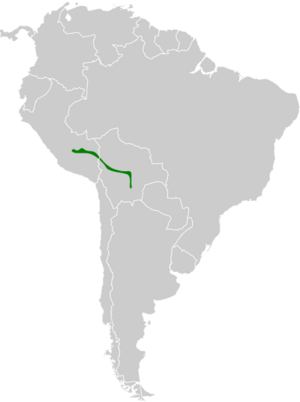Bolivian tapaculo facts for kids
Quick facts for kids Bolivian tapaculo |
|
|---|---|
| Conservation status | |
| Scientific classification | |
| Genus: |
Scytalopus
|
| Species: |
bolivianus
|
 |
|
The Bolivian tapaculo (Scytalopus bolivianus) is a small, secretive bird. It belongs to the Rhinocryptidae family, also known as the tapaculos. These birds are known for being hard to spot. They often hide in dense plants. You can find the Bolivian tapaculo in the forests of Bolivia and Peru.
Contents
Discovering the Bolivian Tapaculo
How Scientists Classified This Bird
Scientists group living things into families. The Bolivian tapaculo is a type of bird. It is part of the tapaculo family. Long ago, scientists thought this bird was a subspecies of another bird. That bird was called the rufous-vented tapaculo.
But then, they listened closely to their songs. The Bolivian tapaculo sings very differently. Because of its unique voice, scientists decided it was its own species. This shows how important bird calls are!
What Does the Bolivian Tapaculo Look Like?
The Bolivian tapaculo is about 12 cm (4.7 in) long. That's about the length of a pencil. Male birds usually weigh between 17 to 22 g (0.60 to 0.78 oz). One female bird was found to weigh 19.5 g (0.69 oz).
Male and Female Differences
The male tapaculo is mostly dark gray. It has reddish-brown feathers on its sides. Its belly and the area under its tail are also reddish-brown. Sometimes, males have a bit of white on the top of their heads.
Female tapaculos are a lighter gray. They have a brownish wash on their upper parts. Their bellies are brown with black stripes. Young tapaculos look similar to the females.
Where Do Bolivian Tapaculos Live?
Exploring Their Home and Habitat
The Bolivian tapaculo lives in two South American countries. You can find them in southeastern Puno Province in Peru. They also live in Bolivia, reaching as far south as Chuquisaca Department.
These birds prefer to live in dense undergrowth. This means thick bushes and plants. They like humid broadleaf forests. These are forests with many trees that have wide leaves.
They usually live at high elevations. Their main home is between 1,000 to 2,300 m (3,300 to 7,500 ft) above sea level. In some special places, they can even be found as high as 2,850 m (9,350 ft).
How Do Bolivian Tapaculos Behave?
Sounds and Calls of the Tapaculo
Scientists are still learning many things about the Bolivian tapaculo. For example, they don't have much information yet on what these birds eat. They also don't know much about their breeding habits.
However, we do know about their interesting calls! Their song is a long trill. It can last up to 15 seconds! You can listen to an example of their song here: Bolivian Tapaculo Song.
When they sense danger, they make an alarm call. It sounds like "kekekeke". You can hear an alarm call here: Bolivian Tapaculo Alarm Call. Female tapaculos are also thought to make a high-pitched "brzk" sound: Female Tapaculo Call.
Protecting the Bolivian Tapaculo
Their Conservation Status
The IUCN (International Union for Conservation of Nature) checks on animals worldwide. They have assessed the Bolivian tapaculo. They consider it a species of "Least Concern". This means it's not currently in danger of disappearing.
Even though its population numbers are not fully known, and might be decreasing, it's not declining fast enough to be listed as threatened. It's good news that these birds live in some national parks and protected areas. These places help keep their homes safe.


